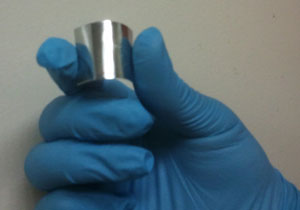| Oct 17, 2011 |
Silver nanoparticle ink for large-scale production of flexible electronics
|
|
(Nanowerk News) Low-cost, lightweight, flexible electronics are now used in a wide range of applications, from radiofrequency identification tags found in items such as public transit smart cards, to the latest flexible displays. As the plastic substrates used for flexible electronics are not compatible with the high temperatures needed for forming metal circuits, researchers have turned to polymers and even carbon-based materials as the conduction medium. Nothing yet, however, compares to the high conductivity provided by metal.
|
 |
| A flexible silver film produced by evaporation of a solvent from silver nanoparticle ink.
|
|
Now, Qing-Hua Xu and co-workers from the National University of Singapore have prepared silver films for flexible electronics at mild fabrication temperatures ("Preparation of Conductive Silver Films at Mild Temperatures for Printable Organic Electronics"). "We wanted to design a process that could be used to produce conductive films on heat-sensitive plastics," explains Xu.
|
|
Patterning metal-based electronic circuits using techniques such as inkjet printing could lead to the cheap, large-area mass-production of high-performance flexible electronics. However, developing the printed nanoparticle inks used in the inkjet process into conductive circuit tracks requires high-temperature annealing, which can damage plastic substrates.
|
|
To print metal nanoparticles using an inkjet process, the particles must first be coated with an insulating organic stabilizer. Once deposited, however, this stabilizer prevents contact between the metal particles and so blocks the conduction of electrons. To solve this problem, Xu and his co-workers stabilized their silver nanoparticles with poly(vinylpyrrolidone). This alternative treatment still allows the nanoparticles to be printed, but it also lets the particles self-aggregate on the substrate simply by evaporating away the printing solvent under low heat.
|
|
The researchers have used their technique to prepare silver films (pictured) for use as metal electrodes in a solar cell, with performance comparable to that for conventional aluminum electrodes produced by vacuum evaporation.
|
|
In the future, the method could be used to fabricate metal contacts in other devices such as field-effect transistors and light-emitting diodes. "The stabilizer we use is ideal for producing silver nanoparticles," explains Xu, "but if we use it to produce gold or alloy nanoparticles, the resulting nanoparticle inks are not very stable. We are now investigating other stabilizers that could prove suitable for producing nanoparticle inks of gold and other metal alloys."
|

